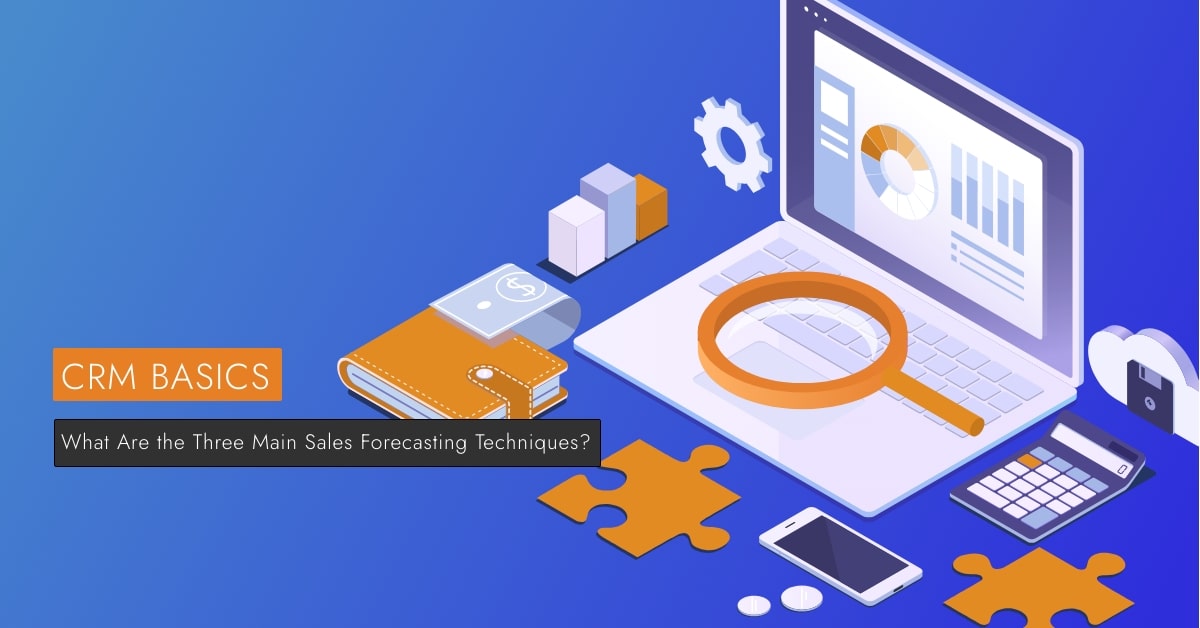What Are the Three Main Sales Forecasting Techniques?

If you work in the sales department of your company, you may have heard of sales forecasting. Any business decision must rely on forecasting, and anyone in the company planning ahead will have to consult a sales forecast in order to make the right decision at the right time.
That means that accurate forecasting is crucial to the success of your company.
What Is Sales Forecasting?
A sales forecast is how much revenue a company can expect to earn over a given period. Sales forecasting is the process of making this prediction using accurate methods that are based on collected data or experience, or both.
Every sales forecast sets out to answer two questions: how much will a company earn and over what period of time?
The Importance Of Sales Forecasting
No executive worth their salt is going to spend company dollars on a blind guess. In fact, decision-makers won’t even consider pulling the trigger on marketing campaigns, production runs, or internal changes without looking at some kind of forecast. Companies don’t want to risk spending money, making a product, or marketing a service without a high probability of success.
With that said, let’s take a look at the main sales forecasting techniques:
#1: The Qualitative Sales Forecasting Technique
This technique relies heavily on the expertise and experience of professionals. In your company, that could be a seasoned sales rep, an experienced manager, or anyone who has accumulated a wealth of knowledge to accurately predict your sales figures.
Why Use the Qualitative Sales Forecasting Technique?
While quantitative data can provide immeasurable value, it’s also beneficial to depend on experts to provide sound judgement on marketing decisions, production, trends, etc.
Unlike quantitative sales forecasting in which predictions are based on numerical values and objective historical data, qualitative sales forecasting is based on opinions of people with experience behind them. Using both methods can provide accurate sales forecasts for your future sales.
Most popular sales forecasting methods:
- The Delphi method
- Expert’s opinion method
- Survey of buyer’s expectations
- Sales force composite method
- Historical analogy method
#2: The Time Series Analysis Method
In the time series analysis method, sales forecasts are made by studying data points that have been collected over a period of time. Using this method, data analysts can see how variables change in specific time periods, which allows them to accurately forecast future sales.
Unlike the qualitative method, the time series analysis method is based strictly on data collected over time.
Why Use the Time Series Analysis Method?
The time series analysis method is important for any company that wants to understand trends. For example, if a company has designed a product and is ready to launch, they can use their analytics to determine their timeline for marketing, production, and distribution.
The time series analysis method is used in various applications. In fact, we’ve been collecting data points and measuring them over time for thousands of years. It’s how our ancestors predicted weather patterns and seasonal changes to help them successfully plant their crops.
The most common modern applications for the time series method include:
- Interest rates
- Stock trading
- Quarterly sales
- Stock prices
#3: The Causal Models Method
As the name suggests, this sales forecasting technique is based on cause and effect. The causal model is considered the most sophisticated type of forecasting technique, as it depends on data to analyse and determine the relationship between independent and dependent variables.
The causal model takes everything into account when forecasting sales numbers, such as current events, seasonal changes, and market survey information. To make a forecast using this method, analysts will first establish the company’s current position and then evaluate all the variables that could influence future sales.
Why Use the Causal Model?
If you have enough historical data to perform an accurate analysis, the causal model will likely give you the best and most accurate sales forecast. If you don’t have all the data you need, however, you will likely have to rely on assumptions until enough data can be collected.
Automated Sales Forecasting
No matter which sales forecasting technique you use, you’re better guaranteed more accurate predictions when you can use machine intelligence to forecast future sales. Customer relationship management systems like Veloxity use machine learning to make highly accurate projections based on your sales team’s inputs.
What Is the Best Sales Forecasting Technique?
When you use a CRM, you no longer need to spend hours tediously analysing sales data. The more information your CRM receives, the more accurately it can predict future sales. This frees up your time and gives you the most accurate prediction to help your company save money and increase your marketing ROI.
Want to see Veloxity’s sales forecasting at work? Try our demo today!
